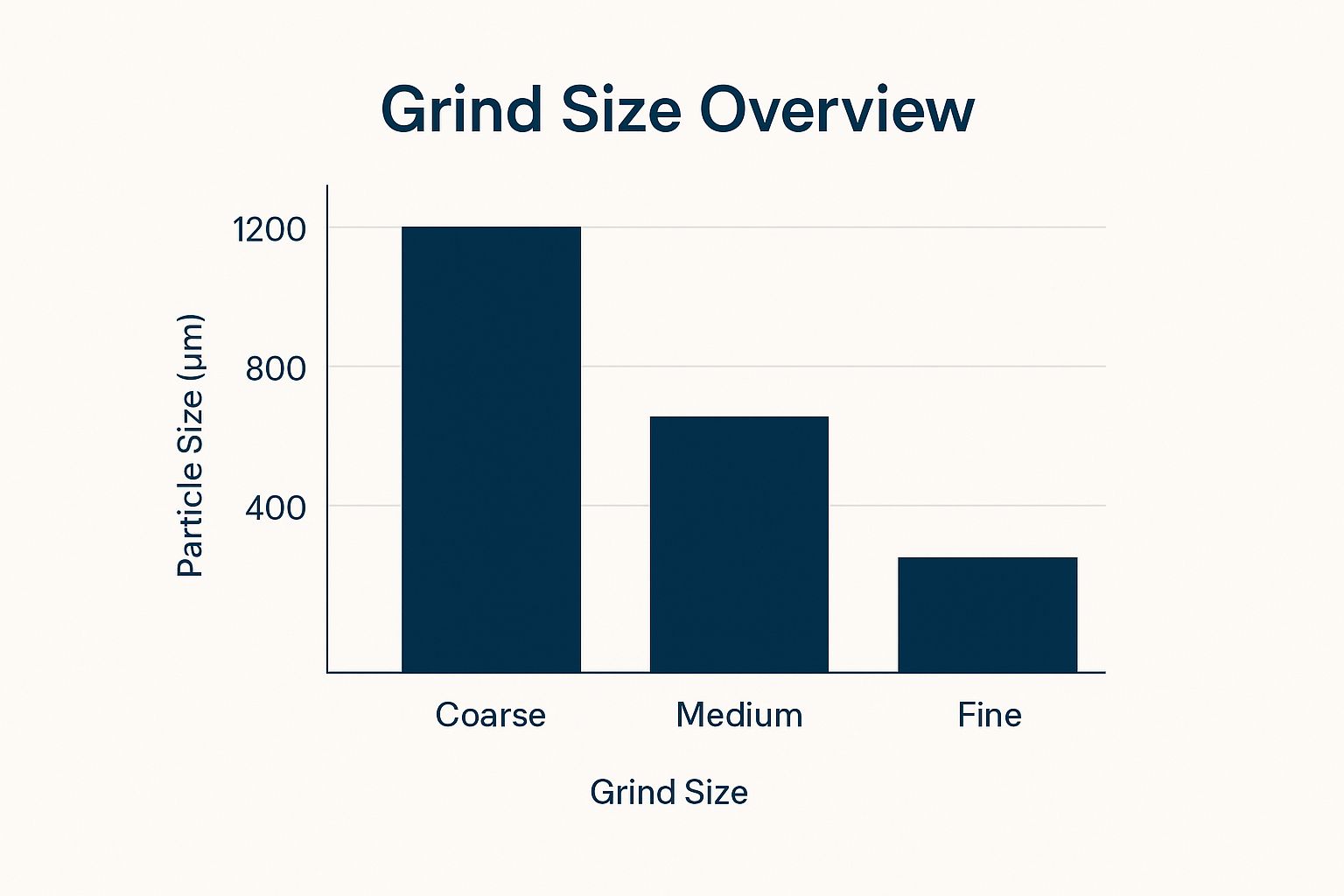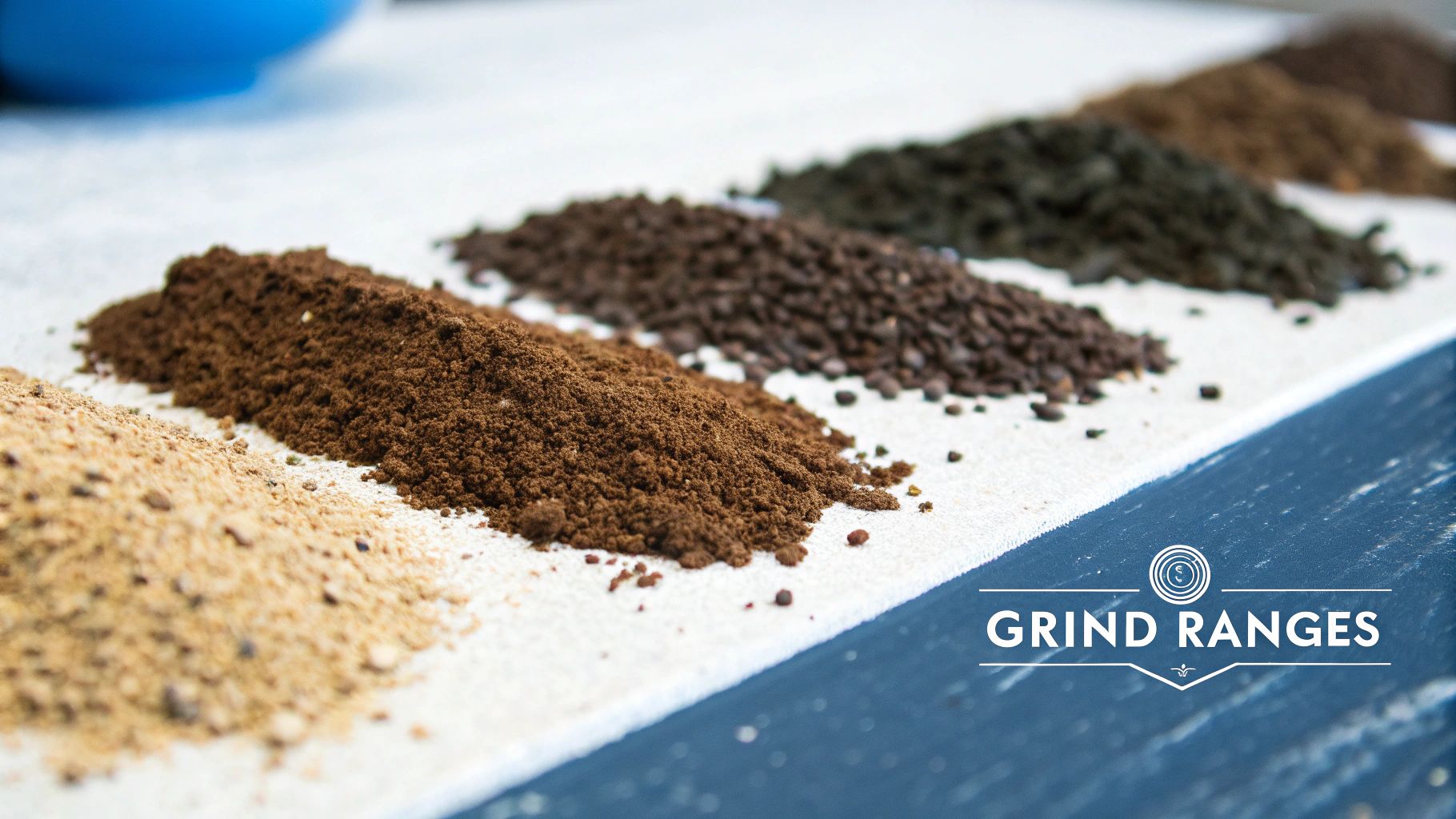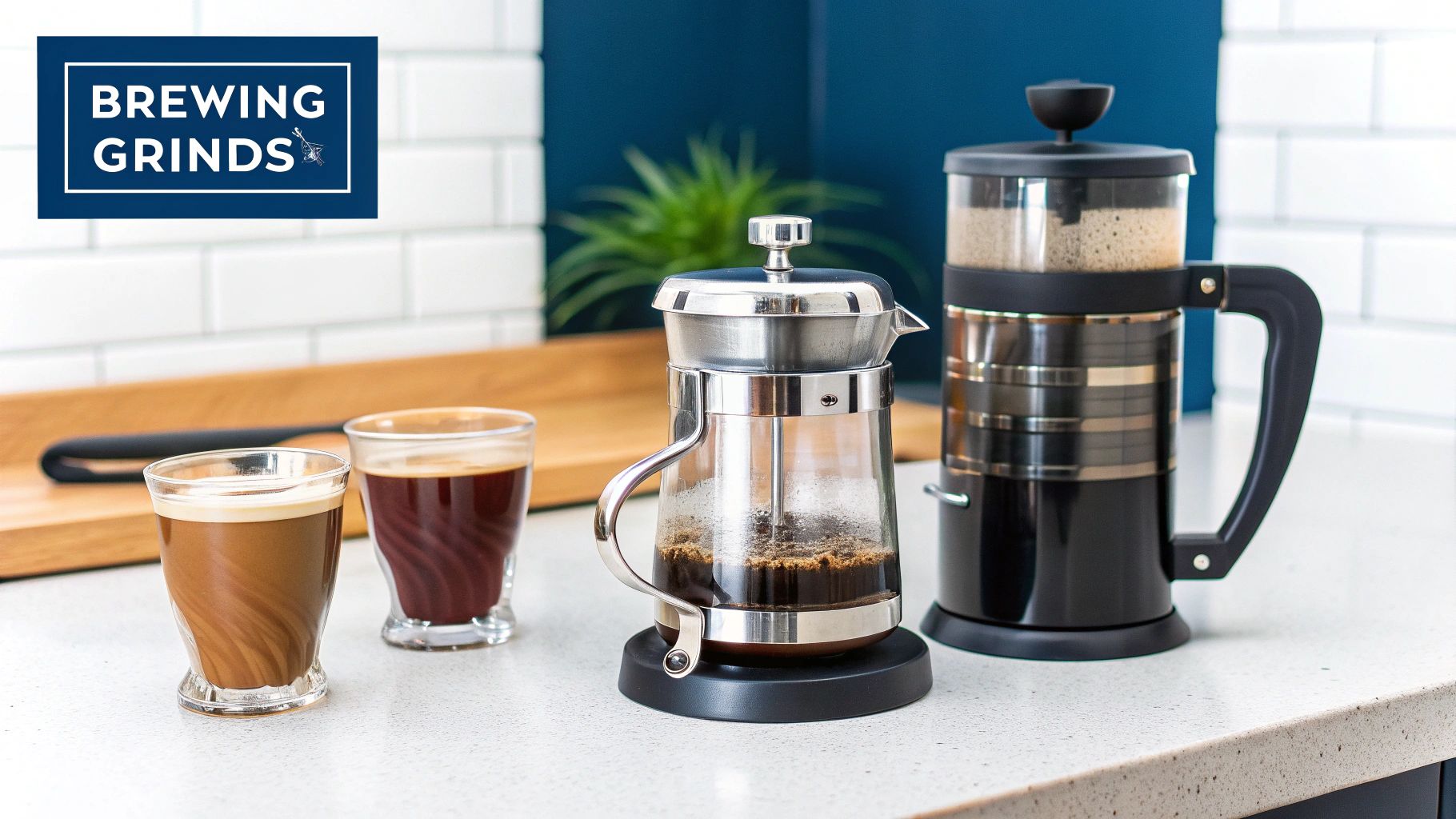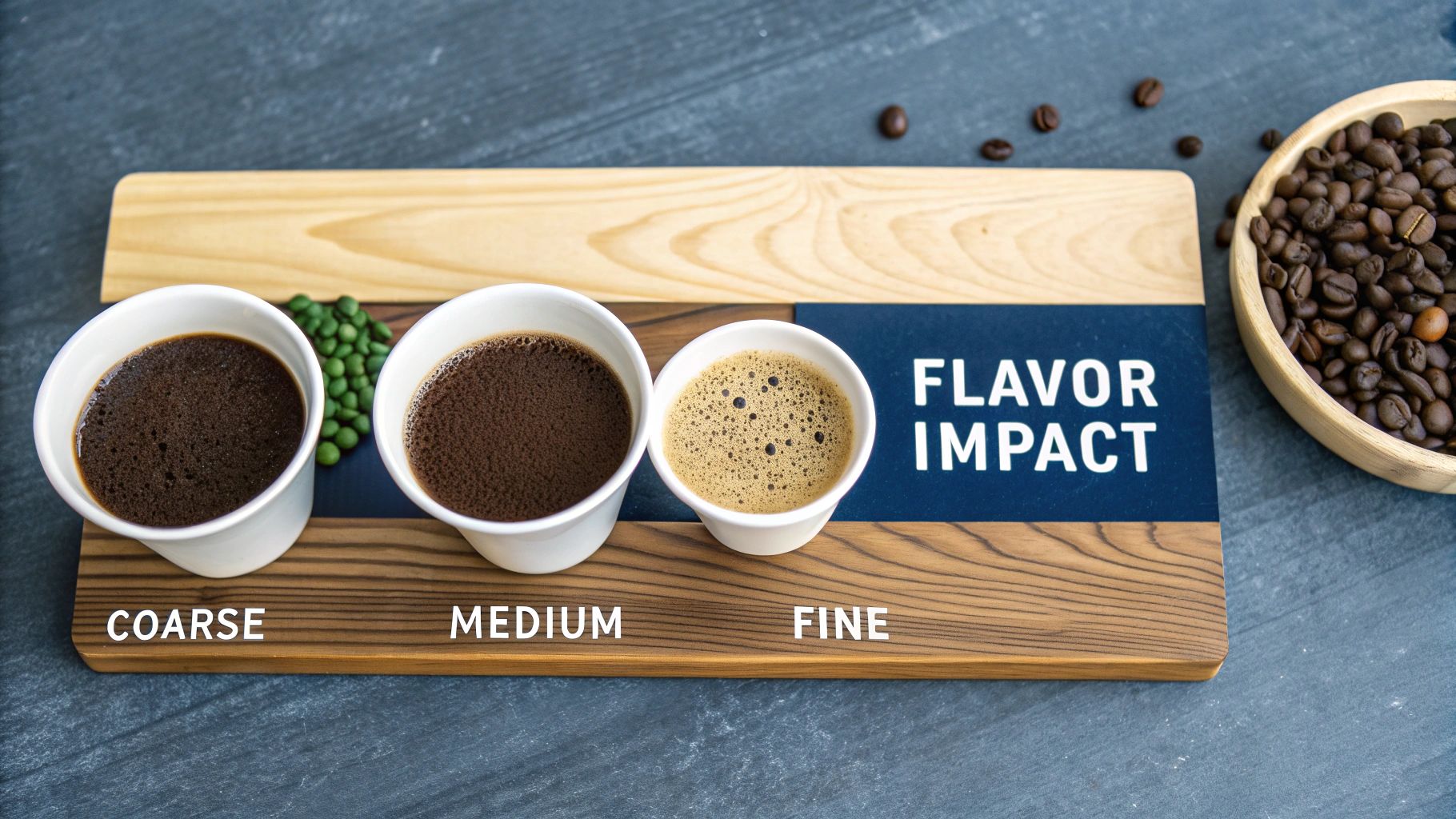UK Coffee Grind Size Chart: Your Ultimate Guide
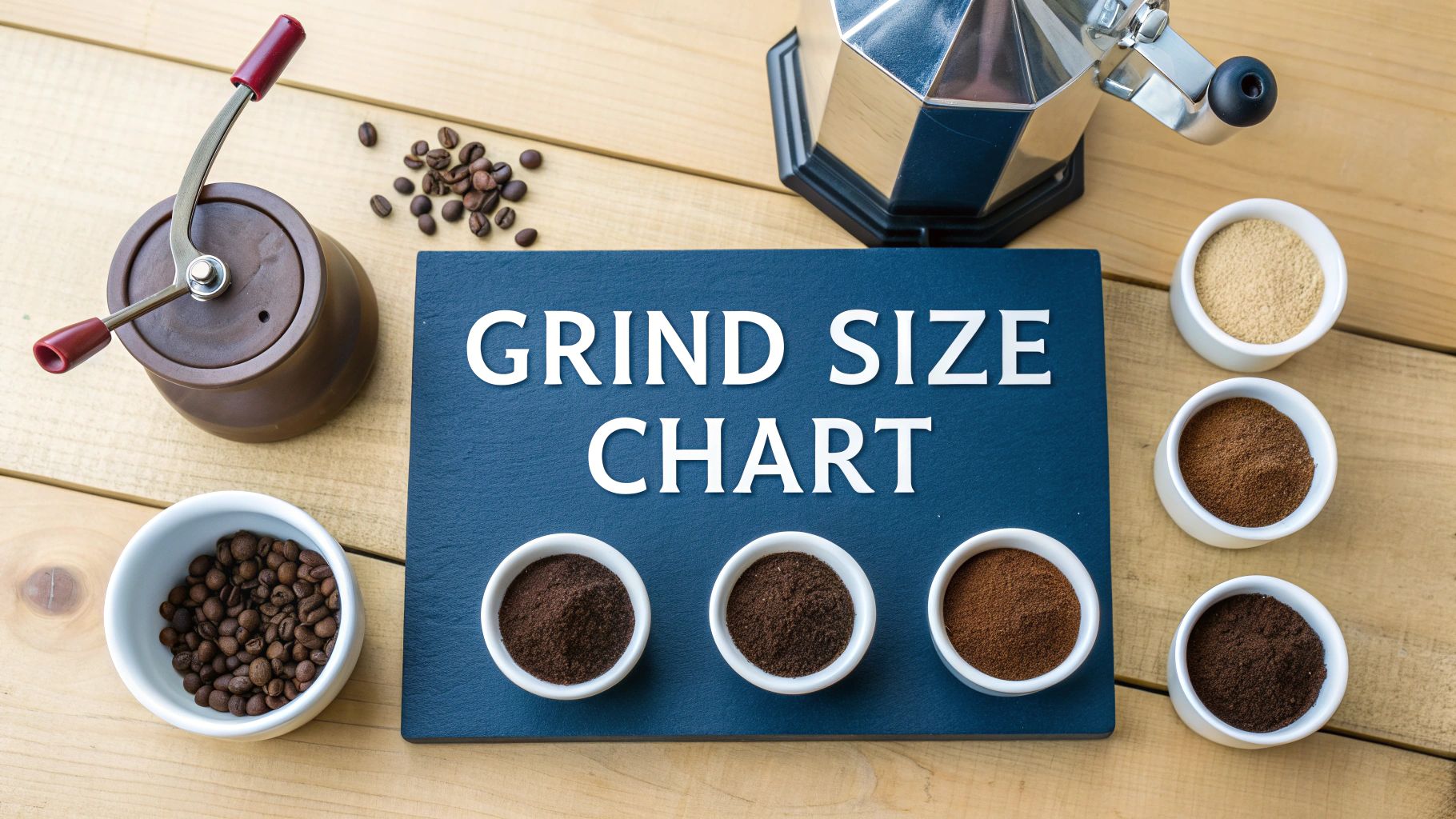
Getting the grind size right is the first step to brewing a genuinely fantastic cup of coffee. Think of a comprehensive coffee grind size chart as your map, matching the texture of your coffee grounds to your favourite brewing method to nail the perfect flavour extraction every single time. A coarse grind, for example, is what you'll need for a French press, while an espresso machine demands a fine grind.
It sounds simple, but getting this right makes all the difference.
Your Quick Reference Grind Size Chart
Honestly, understanding grind size is fundamental to brewing coffee that doesn't disappoint. The texture of your grounds directly controls how quickly water pulls out all those lovely flavour compounds. Go too coarse, and your coffee will taste disappointingly sour and weak. Grind too fine, and you’ll end up with a harsh, bitter brew.
It all comes down to surface area. The size of the coffee particles dictates how much contact they have with the water, which in turn affects the extraction rate. This chart is your starting point—a quick reference to help you match your brewing gear to the right grind without any of the guesswork.
Whether you're using a trusty French press, a delicate V60, or a powerful espresso machine, finding the correct setting is crucial for a beautifully balanced cup. For a deeper dive into the techniques behind the gear, our guide on how to brew coffee is packed with practical tips.
The image below gives you a great visual idea of the particle sizes for the three main grind categories.
As you can see, there’s a massive difference in particle size—measured in microns (µm)—between coarse, medium, and fine grinds. Each jump dramatically changes how water interacts with the coffee, which is exactly why one grind setting will never work for every brewer.
Why Grind Size Is Key to a Perfect Cup
Getting your head around why grind size matters is easily the biggest leap you can make towards brewing café-quality coffee at home. It all comes down to controlling extraction—that’s the process where hot water dissolves all the delicious flavours from your coffee grounds. The size of each little coffee particle is what determines how much of its surface gets exposed to the water.
Think of it like dissolving sugar in your tea. A sugar cube takes its sweet time, but granulated sugar disappears almost instantly. Coffee is no different. A coarse grind has less surface area, which slows down extraction. A fine grind, on the other hand, has a massive surface area, speeding everything up significantly. This relationship between the size of the grounds and the time they spend with water is the absolute foundation of a great brew.
The Problem with the Wrong Grind Size
When the grind isn’t right for your chosen brew method, you end up with a flavour imbalance. This isn't just about personal taste; it's the simple reality of coffee chemistry. You'll inevitably run into one of two classic problems:
- Under-extraction: This is what happens when your grind is too coarse for the brew time. Water just rushes past the grounds without grabbing enough of the good stuff, leaving you with a cup that’s sour, weak, and frankly, a bit disappointing.
- Over-extraction: This occurs if your grind is too fine. The water hangs around for too long, pulling out all sorts of unwanted bitter and harsh compounds. The result is often an astringent and unpleasant brew that sets your teeth on edge.
Nailing that perfect balance is the secret to unlocking all the nuanced and delicious notes your beans have been hiding.
The goal is to grind as fine as you possibly can for your brew method without letting any bitterness creep in. This lets you pull out all the sweet, desirable flavours while leaving the harsh ones behind.
This principle is something UK coffee drinkers have come to understand well. For example, a coarse grind of 1000–2000 microns is perfect for a French press, as it allows for a slow, gentle extraction during immersion. Contrast that with espresso, which demands a super-fine grind of 200–400 microns to get a rapid, intense extraction under high pressure.
For long immersion methods like cold brew, a very coarse grind is non-negotiable to prevent over-extraction during its lengthy steeping time. To get the full story on that, check out our guide on how to make cold brew coffee. Honestly, getting this right is the difference between a truly delicious brew and a cup of pure disappointment.
A Detailed Breakdown of Coffee Grind Sizes
Alright, we've established why matching your grind size to your brew method is non-negotiable. Now it's time to get into the nitty-gritty. Think of this guide as your complete encyclopaedia for coffee grinds—we'll cover clear descriptions, particle sizes, and the absolute best brewers for each one.
Understanding not just what grind to use but why you're using it is the key to perfecting your technique. It empowers you to make small adjustments that lead to a consistently exceptional cup. Each grind level is all about controlling the water's flow rate and contact time, which is fundamental to hitting that sweet spot of balanced flavour. Let's work our way from the biggest particles down to the smallest.
Extra Coarse Grind
An extra coarse grind is exactly what it sounds like: very large, distinct particles that look a lot like crushed peppercorns or chunky breadcrumbs. The pieces are clearly defined, which allows water to pass through with almost no resistance.
This minimal resistance is precisely why this grind is reserved for brew methods with exceptionally long contact times. If you tried this with a finer grind, you’d end up with a muddy, over-extracted brew that’s intensely bitter.
- Visual Description: Chunky, like crushed peppercorns.
- Micron Range: Approximately 1500 µm and above.
- Best For: Cold Brew, Cowboy Coffee.
Take cold brew, for example. The grounds steep in cold water for a whopping 12-24 hours. An extra coarse grind ensures the water can slowly pull out all those sweet, smooth flavours without also extracting the harsh, bitter compounds that a finer grind would release over such a long time.
Coarse Grind
Moving a step finer, a coarse grind resembles the texture of coarse sea salt or polenta. The particles are still large and fairly uniform, creating plenty of space between them for water to flow freely.
This is the go-to grind for full immersion brewing, where the coffee grounds are steeped directly in water for several minutes. Just imagine trying to use a fine grind in a French press—you'd clog the filter and end up with a sludgy, over-extracted mess.
- Visual Description: Like coarse sea salt.
- Micron Range: Approximately 1000-1200 µm.
- Best For: French Press, percolators, coffee cupping.
For a four-minute steep in a French press, a coarse grind allows for a clean press and a full-bodied flavour profile, sidestepping the astringency that comes from over-extraction.
Medium Coarse Grind
A medium-coarse grind is a wonderfully versatile setting that looks like rough, coarse sand. It neatly bridges the gap between the chunky texture needed for full immersion and the finer grinds required for quicker pour-over methods.
This grind size is ideal for brewers that use a combination of immersion and gravity-fed filtration. It provides just enough resistance to slow the water down for a proper extraction but is coarse enough to prevent any clogging or stalling.
- Visual Description: Looks like rough sand.
- Micron Range: Approximately 800-1000 µm.
- Best For: Chemex, Clever Dripper, cafe solo brewers.
The Chemex, with its signature thick paper filter, benefits massively from this grind. It allows for a steady flow rate that produces a stunningly clean, bright cup, highlighting all the nuanced flavours of the beans.
Medium Grind
This is probably the most common grind size out there, often called the standard for automatic drip coffee makers. It has a texture similar to regular granulated sugar or table salt.
A medium grind provides the perfect balance of surface area and resistance for drip coffee machines, where water drips through a bed of coffee at a controlled pace. Go too coarse, and the water rushes through too fast for a weak brew; go too fine, and you risk the basket overflowing.
- Visual Description: Similar to granulated sugar.
- Micron Range: Approximately 600-800 µm.
- Best For: Drip coffee makers, siphon brewers, flat-bottomed pour-overs (e.g., Kalita Wave).
It’s a fantastic starting point for many different brewers and offers a reliable, balanced extraction for your daily morning coffee.
Medium Fine Grind
Now we’re stepping firmly into the world of pour-over brewing. A medium-fine grind has a texture that’s a little finer than table salt but not yet powdery—think fine sand.
This increased surface area is crucial for pour-over methods that require a shorter brew time, typically around 2-3 minutes. The finer particles slow the water’s journey just enough to extract the complex acids and sugars without pulling out excess bitterness.
- Visual Description: Like fine sand or table salt.
- Micron Range: Approximately 400-600 µm.
- Best For: Cone-shaped pour-overs (e.g., Hario V60), AeroPress (for 1-2 minute brews).
A medium-fine grind is often the sweet spot for brewers like the V60. For a detailed walkthrough on perfecting your technique, you can find a complete guide to V60 coffee brewing here, which explains how grind adjustments can transform your final cup.
Fine Grind
A fine grind is what you'll typically find in pre-ground coffee destined for espresso. The texture is much smoother than sugar, almost like a powder, but still feels slightly gritty when you rub it between your fingers.
This grind size is absolutely essential for espresso, where hot, pressurised water is forced through a tightly packed puck of coffee in just 25-30 seconds. The fine particles create the resistance needed to build pressure, allowing for a rapid yet complete extraction.
- Visual Description: Smoother than sugar, slightly gritty.
- Micron Range: Approximately 200-400 µm.
- Best For: Espresso machines, Moka pots, AeroPress (for short, intense brews).
Trying to pull a shot with a coarser grind would give you a weak, sour espresso because the water would just gush through without extracting anything substantial.
Extra Fine Grind
The finest of them all is the extra-fine grind, often called a Turkish grind. It has the consistency of flour or powdered sugar, with no discernible grit at all. This powdery texture is the secret to its unique brewing method.
For Turkish coffee, the ultra-fine grounds are boiled directly with water and aren't filtered out. The powder-like consistency allows some of it to dissolve while the rest settles at the bottom of the cup, creating the rich body and intense flavour this method is famous for.
- Visual Description: Like flour or powdered sugar.
- Micron Range: Below 200 µm.
- Best For: Turkish coffee (Ibrik).
Attempting this with any other grind size would result in a gritty, unpleasant texture, as the particles would be far too heavy to create that characteristic thick brew.
How to Dial In Your Grinder for Any Coffee
A coffee grind size chart gives you a brilliant starting point, but the real secret to a consistently perfect brew is learning to ‘dial in’ your grinder. This is just the process of making small, incremental tweaks based on how your coffee actually tastes. It's about moving beyond static charts to chase that truly balanced cup.
Think of it as fine-tuning your recipe. Even if you use the same beans and brewer every day, things change. The age of the coffee, its roast level, and even the humidity in your kitchen can shift the goalposts for the ideal grind setting. Dialling in is what empowers you to adapt.
Using Taste as Your Guide
When it comes to perfecting your grind, your taste buds are the ultimate tool. The whole game is about finding that ‘sweet spot’ between two unpleasant extremes: sourness and bitterness. Getting a handle on this sensory feedback is the key to making the right adjustments.
The rule of thumb is wonderfully simple:
- If your coffee tastes sour: A sour, thin, or sharp acidic flavour means your coffee is under-extracted. Your grind is too coarse, letting the water rush through too quickly without grabbing enough flavour. You need to grind finer.
- If your coffee tastes bitter: A bitter, harsh, or unpleasantly dry taste means your coffee is over-extracted. The grind is too fine, and the water is sticking around for too long, pulling out undesirable compounds. You need to grind coarser.
By making just one small adjustment at a time, you can zero in on the perfect setting for that specific bag of beans.
Factors That Influence Your Grind Setting
Your grinder’s ideal setting isn't fixed; it’s a moving target influenced by a few different variables. For instance, as coffee beans get older, they lose CO2 and become more brittle. This often means you'll need a slightly finer grind to achieve the same extraction you got when the bag was fresh.
Likewise, darker roasts are more porous and extract much faster, so you’ll probably need a coarser setting compared to a dense, light roast. This attention to detail is especially critical when you're brewing under pressure. To really dig into this, our detailed guide on how to make espresso at home covers how tiny grind adjustments are absolutely vital for pulling the perfect shot.
The professional barista's approach is to grind as fine as possible for any brew method right up to the point of astringency, then step back a notch or two. This ensures you extract the maximum sweetness and flavour without any bitterness.
Choosing the Right Coffee Grinder
While a coffee grind size chart is a vital map, a quality grinder is the vehicle that gets you there. In fact, investing in the right equipment is probably the single biggest step you can take towards better coffee. Consistency is king. Without uniform coffee particles, you’ll always get an uneven extraction—a messy brew with a mix of sour and bitter flavours.
The first choice you'll face is between a blade grinder and a burr grinder. Blade grinders use a spinning blade to violently smash beans into random-sized pieces, creating a chaotic mix of fine dust and large chunks. This inconsistency makes it impossible to achieve a balanced extraction, no matter how carefully you follow a recipe.
Burr Grinders: The Key to Consistency
Burr grinders, on the other hand, are the industry standard for a good reason. They use two abrasive surfaces, or burrs, to crush beans into a uniform size. It’s this consistency that allows for an even extraction, unlocking the true flavour potential of your coffee.
There are two main types of burr grinders to think about:
- Manual Grinders: These are hand-cranked, offering exceptional grind quality at a lower price. They are perfect for brewing single cups and are brilliant for travel, but they can be slow going if you're making coffee for a crowd.
- Electric Grinders: Offering speed and convenience, electric models are ideal for daily use. They provide consistent results at the push of a button, with higher-end models offering incredibly precise adjustments for all sorts of brew methods.
A quality burr grinder doesn't just make good coffee easier; it makes great coffee possible. It’s the tool that lets you apply the knowledge from a grind chart with precision and repeatability.
Ultimately, the best grinder is one that lines up with your brewing habits and budget. But whether it's manual or electric, choosing a burr model is a non-negotiable step for anyone who's serious about their coffee. For more guidance on pairing your grinder with the right technique, explore our overview of the best coffee brewing methods.
Of course. Here is the rewritten section, crafted to sound completely human-written and natural, following all your requirements.
Common Grinding Mistakes and How to Avoid Them
Even with the perfect coffee grind size chart in hand, a few common slip-ups can easily get in the way of a truly great brew. Steering clear of these is one of the simplest ways to elevate your daily coffee ritual and finally achieve that consistent, delicious flavour you're after.
One of the biggest culprits is grinding your beans too far ahead of time. The moment coffee is ground, it starts losing its incredible aromatic compounds to the air—a process known as oxidation. If you want the most flavour and aroma packed into your cup, grinding just seconds before you start brewing is non-negotiable.
Another all-too-common issue is sticking with a blade grinder. These gadgets don't grind; they smash. You end up with a chaotic mix of fine dust and large chunks, which leads to a messy, uneven extraction. The result? A muddled cup where some grounds are over-extracted and bitter, while others are under-extracted and sour. A quality burr grinder is the only way to get the uniform particle size you need.
Refining Your Workflow
It's often the small tweaks to your process that make the biggest difference. For instance, to deal with static and retention—that annoying way grounds cling to every surface of your grinder—many baristas swear by the Ross Droplet Technique (RDT).
The Ross Droplet Technique is surprisingly simple: just add a tiny spritz of water to your whole beans before grinding. This one action almost completely eliminates static, giving you a much cleaner grind with far less mess to clean up.
Finally, don't let a dirty grinder spoil your coffee. Old coffee oils and fine particles build up inside the burrs over time, turning rancid and imparting stale, unpleasant flavours into your otherwise fresh brew. A quick clean every few weeks is all it takes to ensure every cup tastes exactly as it should. These small refinements will help you get the absolute most out of every single bean.
A Few Common Questions About Grind Size
Even with a detailed coffee grind size chart in hand, some practical questions always seem to pop up mid-brew. This section is all about giving you clear, straightforward answers to the queries we hear most often, helping you troubleshoot on the fly and put all this knowledge into practice.
Think of this as the bridge between theory and your morning cup. From tricky adjustments for different roast levels to understanding why pre-ground coffee just doesn't cut it, these answers are designed to build your confidence and refine your technique.
Can I Use One Grind Size for All Coffee?
It’s a tempting idea, but unfortunately, a one-size-fits-all approach just doesn't work for coffee. Every brew method is a unique little ecosystem, and each one needs a specific grind size to get the extraction just right.
Take a French press, for instance. Its coarse grind is designed for a slow, 4-minute steep, letting the water gently pull out the flavours. On the other end of the spectrum, espresso needs a super-fine grind to create enough resistance for a quick, high-pressure 30-second shot. If you get them mixed up, you’ll either end up with a sour, under-extracted brew or a bitter, over-extracted one.
How Does Roast Level Affect Grind Size?
Great question. The roast level of your beans is a huge factor in dialling in your grinder. Darker roasts are more brittle and porous, which means they give up their flavours much more easily. To keep things balanced and avoid bitterness, you’ll almost always need to use a slightly coarser grind for dark roasts.
On the flip side, light roasts are much denser and less soluble. To make sure you’re pulling out all their complex, delicate flavours within the brew time, you’ll need to go for a finer grind. This increases the surface area and helps the water do its job properly.
Why Does My Pre-Ground Coffee Taste Stale?
Pre-ground coffee loses its magic incredibly fast, and the culprit is oxidation. The moment you grind coffee, you dramatically increase its surface area, exposing all those wonderful aromatic oils to the air. Oxygen gets to work immediately, and the flavours start to degrade.
This is exactly why coffee ground just seconds before brewing tastes so much more vibrant and alive. While pre-ground is convenient, it simply can’t compete with the flavour and aroma you get from fresh beans.
This push for freshness is definitely catching on. In 2024, while a surprising 73% of the UK population still drinks instant coffee, there’s a clear shift towards freshly ground beans, especially with millennials. This group, which makes up about 16% of UK coffee buyers, is really driving the demand for precision. It's why grind charts with specific micron ranges—like 200-400 µm for espresso—are more useful than ever. For more on this, you can find some fascinating insights into UK coffee consumption trends on gcrmag.com.
At Seven Sisters Coffee Co, we believe that the right beans are the foundation of an incredible cup. Explore our selection of single-origin and blended coffees, roasted with care to bring out their unique character. Find your perfect coffee today.

